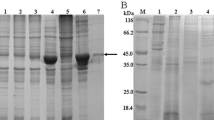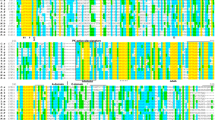Abstract
Lactate dehydrogenase (LDH) is a terminal enzyme in anaerobic glycolytic pathway. It widely exists in various organisms and is in charge of converting the glycolysis product pyruvic acid to lactic acid. Most parasites, including Clonorchis sinensis, predominantly depend on glycolysis to provide energy. Bioinformatic analysis predicts that the LDHs from many species have more than one transmembrane region, suggesting that it may be a membrane protein. C. sinensis LDH (CsLDH) has been confirmed as a transmembrane protein mainly located in the tegument. The antibodies against CsLDH can inhibit the worm’s energy metabolism, kill the worm, and may have the same effects on human cancer cells. In this study, we cloned and characterized human LDHA (HsLDHA), HsLDHB, and CsLDH. Semi-quantitative real-time RCP showed that HsLDHB only existed in hepatocarcinoma cell SMMC-7721. Confocal microscopy and Western blot experiments revealed that HsLDHB was localized in the plasma membrane of SMMC-7721 cells, and the antibodies against CsLDH could cross-react with it. This cross-reaction could inhibit the enzymatic activity of HsLDHB. The cancer cells co-cultured with anti-CsLDH sera showed a significant decrease in cell proliferation rate and increases in caspase 9 and reactive oxygen species (ROS) levels. Therefore, anti-CsLDH antibodies can induce the apoptosis of cancer cells SMMC-7721 and may serve as a new tool to inhibit tumor.








Similar content being viewed by others
References
Augoff K, Grabowski K (2004) Significance of lactate dehydrogenase measurements in diagnosis of malignancies. Pol Merkur Lekarski 17(102):644–647
Bobba A, Amadoro G, La Piana G, Calissano P, Atlante A (2015) Glycolytic enzyme upregulation and numbness of mitochondrial activity characterize the early phase of apoptosis in cerebellar granule cells. Apoptosis 20(1):10–28. doi:10.1007/s10495-014-1049-1
Burtis CA, Ashwood ER, Bruns DE (2012) Tietz textbook of clinical chemistry and molecular diagnostics. Elsevier Health Sciences
DeBerardinis RJ, Mancuso A, Daikhin E, Nissim I, Yudkoff M, Wehrli S, Thompson CB (2007) Beyond aerobic glycolysis: transformed cells can engage in glutamine metabolism that exceeds the requirement for protein and nucleotide synthesis. Proc Natl Acad Sci U S A 104(49):19345–19350. doi:10.1073/pnas.0709747104
DeBerardinis RJ, Lum JJ, Hatzivassiliou G, Thompson CB (2008) The biology of cancer: metabolic reprogramming fuels cell growth and proliferation. Cell Metab 7(1):11–20. doi:10.1016/j.cmet.2007.10.002
Draoui N, Feron O (2011) Lactate shuttles at a glance: from physiological paradigms to anti-cancer treatments. Dis Model Mech 4(6):727–732. doi:10.1242/dmm.007724
Ebert BL, Gleadle JM, O’Rourke JF, Bartlett SM, Poulton J, Ratcliffe PJ (1996) Isoenzyme-specific regulation of genes involved in energy metabolism by hypoxia: similarities with the regulation of erythropoietin. Biochem J 313(Pt 3):809–814
Fischer K, Hoffmann P, Voelkl S, Meidenbauer N, Ammer J, Edinger M, Gottfried E, Schwarz S, Rothe G, Hoves S, Renner K, Timischl B, Mackensen A, Kunz-Schughart L, Andreesen R, Krause SW, Kreutz M (2007) Inhibitory effect of tumor cell-derived lactic acid on human T cells. Blood 109(9):3812–3819. doi:10.1182/blood-2006-07-035972
Gan W, Zhao G, Xu H, Wu W, Du W, Huang J, Yu X, Hu X (2010) Reverse vaccinology approach identify an Echinococcus granulosus tegumental membrane protein enolase as vaccine candidate. Parasitol Res 106(4):873–882. doi:10.1007/s00436-010-1729-x
Harris MT, Mitchell WG, Morris JC (2014) Targeting protozoan parasite metabolism: glycolytic enzymes in the therapeutic crosshairs. Curr Med Chem 21(15):1668–1678
Huang J, Hu XC, Wu X, Xu J, Yu XB, Bao HE, Lang SY, Liao XJ (2008) Cloning and prokaryotic expression of malate dehydrogenase gene of Taenia saginata asiatica and immunogenicity analysis of the recombinant protein. Zhongguo Ji Sheng Chong Xue Yu Ji Sheng Chong Bing Za Zhi 26(4):268–271
Huang J, Huang Y, Wu X, Du W, Yu X, Hu X (2009) Identification, expression, characterization, and immunolocalization of lactate dehydrogenase from Taenia asiatica. Parasitol Res 104(2):287–293. doi:10.1007/s00436-008-1190-2
Icard P, Lincet H (2013) The cancer tumor: a metabolic parasite? Bull Cancer 100(5):427–433. doi:10.1684/bdc.2013.1742
Le A, Cooper CR, Gouw AM, Dinavahi R, Maitra A, Deck LM, Royer RE, Vander Jagt DL, Semenza GL, Dang CV (2010) Inhibition of lactate dehydrogenase A induces oxidative stress and inhibits tumor progression. Proc Natl Acad Sci U S A 107(5):2037–2042. doi:10.1073/pnas.0914433107
Lee JH, Yang HM, Bak UB, Rim HJ (1994) Promoting role of Clonorchis sinensis infection on induction of cholangiocarcinoma during two-step carcinogenesis. Korean J Parasitol 32(1):13–18
Lim JH (2011) Liver flukes: the malady neglected. Korean J Radiol 12(3):269–279. doi:10.3348/kjr.2011.12.3.269
Lu G, Hu X, Peng Z, Xie H, Li Y, Wu Z, Yu X (2006) Expression and characterization of lactate dehydrogenase from Schistosoma japonicum. Parasitol Res 99(5):593–596. doi:10.1007/s00436-006-0152-9
Martinez-Outschoorn UE, Lin Z, Trimmer C, Flomenberg N, Wang C, Pavlides S, Pestell RG, Howell A, Sotgia F, Lisanti MP (2011) Cancer cells metabolically “fertilize” the tumor microenvironment with hydrogen peroxide, driving the Warburg effect: implications for PET imaging of human tumors. Cell Cycle 10(15):2504–2520
Miao P, Sheng S, Sun X, Liu J, Huang G (2013) Lactate dehydrogenase A in cancer: a promising target for diagnosis and therapy. IUBMB Life 65(11):904–910. doi:10.1002/iub.1216
Pauwels EK, Sturm EJ, Bombardieri E, Cleton FJ, Stokkel MP (2000) Positron-emission tomography with [18F]fluorodeoxyglucose. Part I. Biochemical uptake mechanism and its implication for clinical studies. J Cancer Res Clin Oncol 126(10):549–559
Pavlides S, Whitaker-Menezes D, Castello-Cros R, Flomenberg N, Witkiewicz AK, Frank PG, Casimiro MC, Wang C, Fortina P, Addya S, Pestell RG, Martinez-Outschoorn UE, Sotgia F, Lisanti MP (2009) The reverse Warburg effect: aerobic glycolysis in cancer associated fibroblasts and the tumor stroma. Cell Cycle 8(23):3984–4001
Schwartz MK (1991) Lactic dehydrogenase. An old enzyme reborn as a cancer marker? Am J Clin Pathol 96(4):441–443
Selivanov EV, Barkagan ZS, Zviagintsev EN (2000) Biochemical characteristics of liver involvement in patients with antiphospholipid syndrome. Klin Lab Diagn 12:17–19
Shin HR, Oh JK, Masuyer E, Curado MP, Bouvard V, Fang YY, Wiangnon S, Sripa B, Hong ST (2010) Epidemiology of cholangiocarcinoma: an update focusing on risk factors. Cancer Sci 101(3):579–585. doi:10.1111/j.1349-7006.2009.01458.x
Vander Heiden MG, Cantley LC, Thompson CB (2009) Understanding the Warburg effect: the metabolic requirements of cell proliferation. Science 324(5930):1029–1033. doi:10.1126/science.1160809
Warburg O (1928) The chemical constitution of respiration ferment. Science 68(1767):437–443. doi:10.1126/science.68.1767.437
Warburg O (1956) On the origin of cancer cells. Science 123(3191):309–314
Warburg OH (2010) The classic: The chemical constitution of respiration ferment. Clin Orthop Relat Res 468(11):2833–2839. doi:10.1007/s11999-010-1534-y
Xu XD, Shao SX, Jiang HP, Cao YW, Wang YH, Yang XC, Wang YL, Wang XS, Niu HT (2015) Warburg effect or reverse Warburg effect? A review of cancer metabolism. Oncol Res Treat 38(3):117–122. doi:10.1159/000375435
Yang G, Jing C, Zhu P, Hu X, Xu J, Wu Z, Yu X (2006) Molecular cloning and characterization of a novel lactate dehydrogenase gene from Clonorchis sinensis. Parasitol Res 99(1):55–64. doi:10.1007/s00436-005-0125-4
Young ND, Campbell BE, Hall RS, Jex AR, Cantacessi C, Laha T, Sohn WM, Sripa B, Loukas A, Brindley PJ, Gasser RB (2010) Unlocking the transcriptomes of two carcinogenic parasites, Clonorchis sinensis and Opisthorchis viverrini. PLoS Negl Trop Dis 4(6):e719. doi:10.1371/journal.pntd.0000719
Author information
Authors and Affiliations
Corresponding authors
Additional information
Tianzhang Song and Wenjia Gan contributed equally to this work.
Rights and permissions
About this article
Cite this article
Song, T., Gan, W., Chen, J. et al. Antibodies against Clonorchis sinensis LDH could cross-react with LDHB localizing on the plasma membrane of human hepatocarcinoma cell SMMC-7721 and induce apoptosis. Parasitol Res 115, 1595–1603 (2016). https://doi.org/10.1007/s00436-015-4895-z
Received:
Accepted:
Published:
Issue Date:
DOI: https://doi.org/10.1007/s00436-015-4895-z




